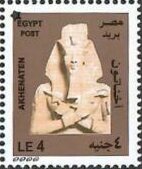Stamp: Akhenaton (with Security Star Punch) (Egypt 2022)
Akhenaton (with Security Star Punch) (Egypt 2022)
01 March (Egypt ) within release Akhenaton (with Security Star Punch) goes into circulation Stamp Akhenaton (with Security Star Punch) face value 4 Egyptian pound
| Stamp Akhenaton (with Security Star Punch) in catalogues | |
|---|---|
| Colnect codes: | Col: EG 2022-04 |
Stamp is square format.
|
Data entry completed
50%
|
|
|---|---|
| Stamp Akhenaton (with Security Star Punch) in digits | |
| Country: | Egypt |
| Date: | 2022-03-01 |
| Print: | Offset lithography |
| Emission: | Definitive |
| Format: | Stamp |
| Face Value: | 4 Egyptian pound |
Stamp Akhenaton (with Security Star Punch) it reflects the thematic directions:
King is the title given to a male monarch in a variety of contexts. The female equivalent is queen regnant (while the title of queen on its own usually refers to the consort of a king). In the context of prehistory, antiquity and contemporary indigenous peoples, the title may refer to tribal kingship. Germanic kingship is cognate with Indo-European traditions of tribal rulership (c.f. Indic rājan, Gothic reiks, and Old Irish rí, etc.) In the context of classical antiquity, king may translate Latin rex or either Greek archon or basileus. In classical European feudalism, the title of king as the ruler of a kingdom is understood as the highest rank in the feudal order, potentially subject, at least nominally, only to an emperor (harking back to the client kings of the Roman Empire). In a modern context, the title may refer to the ruler of one of a number of modern monarchies (either absolute or constitutional). The title of king is used alongside other titles for monarchs, in the West prince, emperor, archduke, duke or grand duke, in the Middle East sultan or emir; etc. Kings, like other royalty, tend to wear purple because purple was an expensive color to wear in the past.
A monument is a type of structure that was explicitly created to commemorate a person or event, or which has become relevant to a social group as a part of their remembrance of historic times or cultural heritage, due to its artistic, historical, political, technical or architectural importance. Examples of monuments include statues, (war) memorials, historical buildings, archaeological sites, and cultural assets. If there is a public interest in its preservation, a monument can for example be listed as a UNESCO World Heritage Site. The Palgrave Encyclopedia of Cultural Heritage and Conflict gives the next definition of monument:
Sculpture is the branch of the visual arts that operates in three dimensions. Sculpture is the three-dimensional art work which is physically presented in the dimensions of height, width and depth. It is one of the plastic arts. Durable sculptural processes originally used carving (the removal of material) and modelling (the addition of material, as clay), in stone, metal, ceramics, wood and other materials but, since Modernism, there has been almost complete freedom of materials and process. A wide variety of materials may be worked by removal such as carving, assembled by welding or modelling, or moulded or cast.


